Can You Change To Shr-2 From Shr Later?
Years ago, somebody asked me near my near important slice of tech and was surprised when I said information technology was my Synology DS410 NAS server and not the smartphone I was property.
That was true so. And it'southward fifty-fifty more than so now.
Additionally, with the benefits of hindsight and real-world usage, I'one thousand also more confident that nobody beats Synology when it comes to NAS servers.
Indeed, I used to accept servers of different vendors — WD, QNAP, Netgear, Lacie, Asus, TerraMaster, to proper name a few. Now I only keep nearly a dozen from Synology in my fleet.
If you lot're wondering what I'm talking virtually, this post is for you. And even if you already know about network-attached storage, chances are yous'll learn a thing or ii.
I'll explain in this mail, in layman'southward terms, NAS in general, and the steps to go a Synology server up and running.
Dong's note:I originally published this piece on Mar 14, 2018, and did a major update on Aug 2, 2021, to include additional, upwards-to-date, and relevant information, including that of the latest DSM 7. This is not a sponsored mail service.
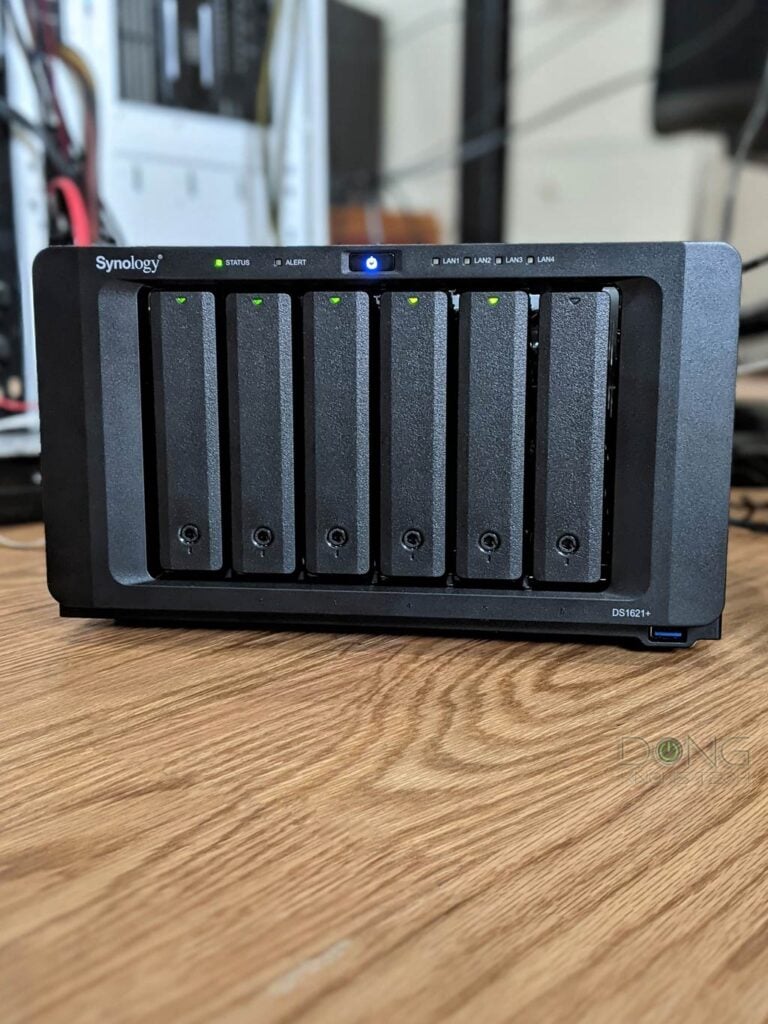
What'south a NAS server?
NAS is non a name — it would be a terrible i — but an acronym for network-fastened storage.
A NAS server is similar to an external drive, simply it connects to a router (or a switch) via its network port. And that makes a earth of difference.
NAS server vs. external drive
An external drive connects directly to a computer, probable via a USB or Thunderbolt port — information technology'southward a direct-attached storage (DAS) device.
For this reason, a DAS device, like those on this list of summit portable drives, works only with one host at a time. As well, it generally just adds additional storage space and not much else.
(Sure, y'all can adhere an external drive to sure routers via a USB port and make the data information technology stores bachelor to the rest of the network. Only that's only a way to turn your router into a pseudo-NAS server.)
On the other hand, a NAS server is available to the entire network and can deliver much more. You literally connect a NAS server's network port to your router or switch via a network cable.
Just similar most servers, a NAS server can provide many services, such as serving content to streamers, hosting personal cloud storage or a fill-in destination, working as a mail server, running virtual machines, and a lot more — all at the same time. The possibility is endless.
(OK. Accept "countless" with a grain of salt. Different applications require different amounts of resources, and a server, NAS or not, can exercise only and so much at a given time.)
And as for storage, NAS servers can house multiple internal drives to host lots of storage infinite with redundancy. Amongst other things, this is the key to the survival of your data.
Then to understand a NAS server well, nosotros starting time need to know RAID. (Already in the know? You tin jump to the Synology Hybrid RAID section.)
Back-up, via the use of RAID, explained
In data storage, redundancy is the use of extra disks (or drives) that are not strictly necessary to provide the storage infinite but to prepare for when a disk fails unexpectedly.
You lot then have the option to fix that without losing any data or even having to put your system offline.
You lot get redundancy by using a RAID or a redundant array of independent disks. Different types of RAID deliver different levels of performance and resiliency — the tolerance against bulldoze failures –. Even so, they all depend on how much storage space you're willing to put bated for it.
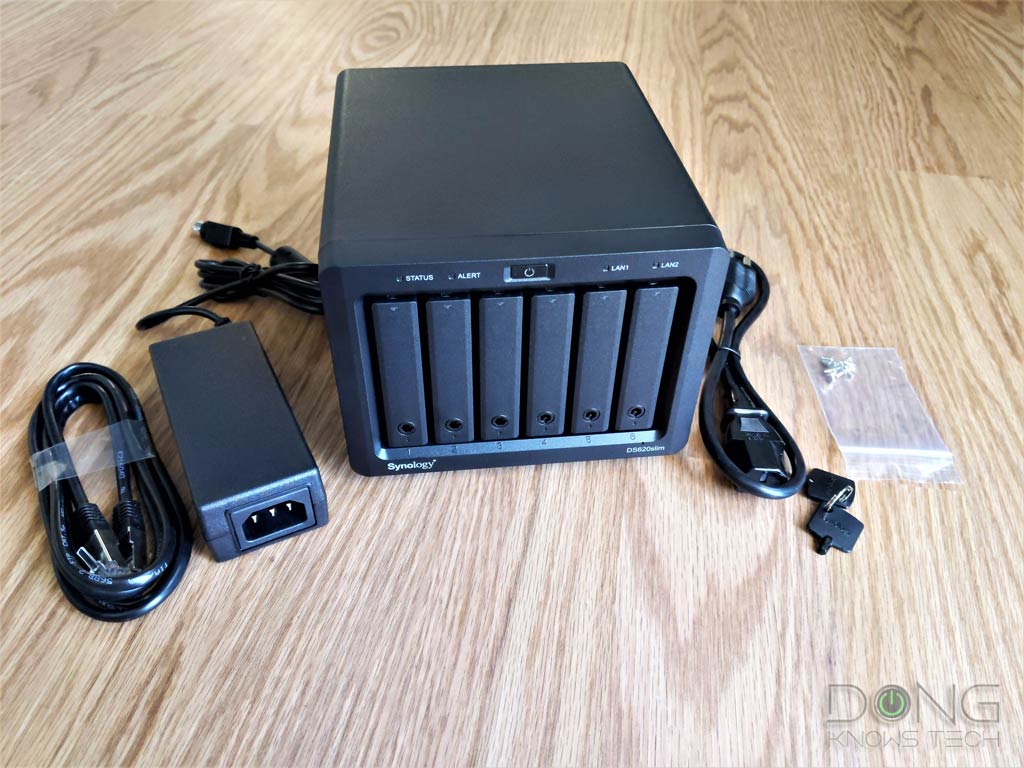
Standard (classic/conventional) RAID setups
Every bit the proper noun suggests, y'all can lump many disks into a single storage entity with RAID.
Depending on the number of disks in employ, you lot have the following pop standard RAID setups — there are more, only you don't have to worry about them.
RAID 0
RAID 0 is the simply not-redundancy RAID.
Also known as deejay-striping, RAID 0 combines two (or more) disks into a single volume.
This volume has the storage space of all involved disks' combined chapters. For case, if you use two 2TB drives in RAID 0, you'll get a 4TB book.
RAID 0 delivers fast performance by writing one re-create of data to multiple disks — each disk only needs to concord a portion of the data — and therefore cutting down the amount of writing each disk has to exercise.
In render, RAID 0 has no data protection. If one of the drives fails, the RAID is expressionless — yous'll lose data on all disks with no take chances of recovering information technology in total.
RAID 1
Besides known as disk-mirroring, RAID i is the opposite of RAID 0. It combines two drives into a unmarried volume with the capacity of just one.
Again, if yous utilize two 2TB drives in RAID 1, you'll notwithstanding get a 2TB capacity. For this reason, your data survive if 1 of the two disks fails.
In return, RAID one'south operation is slow since it has to write two copies of data to two physical disks — that's double the amount of writing.
RAID 5
This RAID setup requires three or more drives. Information technology uses 1 of them as redundancy, so it has the capacity of all involved drives minus one.
For example, if you apply 3 2TB drives, you'll get 4TB protected storage infinite; v will render 8TB, and so on.
RAID 5 delivers capacity, redundancy, and functioning but favors speed over resiliency. In a RAID 5 setup, your data is safe when ane of the involved drives fails.
RAID half-dozen
This RAID setup is similar to RAID v, but it requires four or more drives and cares more about back-up by setting aside 2 drives for data protection. That said, in a RAID half dozen, your information survives fifty-fifty if 2 drives fail at the same time.
If yous utilize four drives, RAID 6 is somewhat similar RAID 1 mentioned above or RAID 10 below.
RAID 10
This is a standard nested RAID setup, a combination of RAID one and RAID 0.
RAID 10 It requires four drives and delivers both performance and data protection. RAID 10 has 100% data safety confronting one bulldoze failure and a l% chance against the instance when two drives fail simultaneously.
RAID rebuild
When a drive in a redundancy RAID fails, the RAID is now "degraded." The storage device will give you lot a notification via indicator lights or beeps. When this happens, you need to replace the failed drive for the RAID to rebuild itself.
The rebuild process can take a long time — hours or even days — depending on the amount of data the RAID stores. Just during this fourth dimension, yous tin can still utilize the server, just at (slightly) slower overall functioning.
A RAID rebuild can exist stressful for the rest of the disks in the array. For this reason, it'due south a skillful idea to reduce the loads on your server during this time.
Standard RAID requirements and drawbacks
All standard RAID setups require drives of the same chapters. You can mix drives of different sizes, simply all will deliver the same amount of storage equally the lowest-chapters ane.
For example, if y'all utilise a 1TB, a 2TB, and a 3TB drives together, all of them will exist regarded equally 1TB drives — you have access to a total of just 3TB of raw storage space, and not 6TB.
In other words, when combing drives of mixed capacities, you'll waste the surplus storage spaces on the higher-capacity drives.
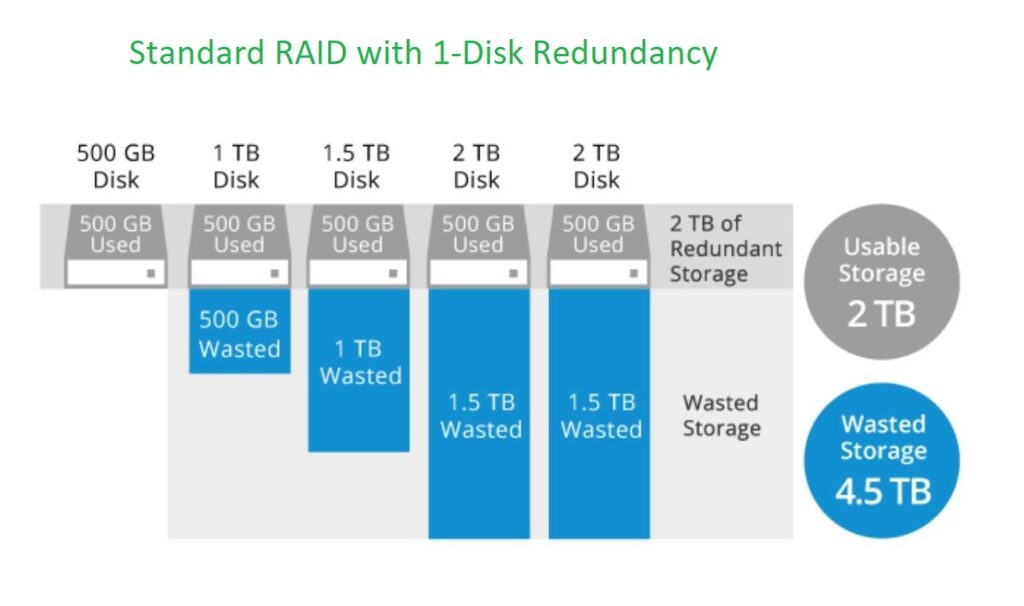
As well, there's no way to scale up the storage infinite in a standard RAID. If you want to increment the RAID's capacity, you'll have to follow these steps:
- Back up the RAID's information to another device.
- Rebuild the RAID from scratch with higher capacities drives.
- Restore the data from the backup.
The whole process is quite fourth dimension-consuming and requires the server to be taken out of service.
These shortcomings of standard RAIDs are where Synology comes into play.
Synology Hybrid RAID
Also supporting all archetype RAIDs, Synology NAS servers too uniquely characteristic a proprietary RAID setup chosen Synology Hybrid RAID (SHR).
SHR is an automated storage direction system that, at its core, is similar to standard RAIDs.
For example, when you utilise 2 drives, SHR works like RAID 1; with three or more, SHR is now identical to RAID 5. You always have a book that's resilient against a single drive failure.
However, SHR has one meaning difference: Information technology efficiently supports drives of dissimilar capacities. As a result:
- You won't waste storage space when mixing drives of various storage sizes.
- Yous tin conveniently scale up a server's storage space without having to rebuild the RAID from scratch, by replacing the RAID with larger drives, ane by 1.
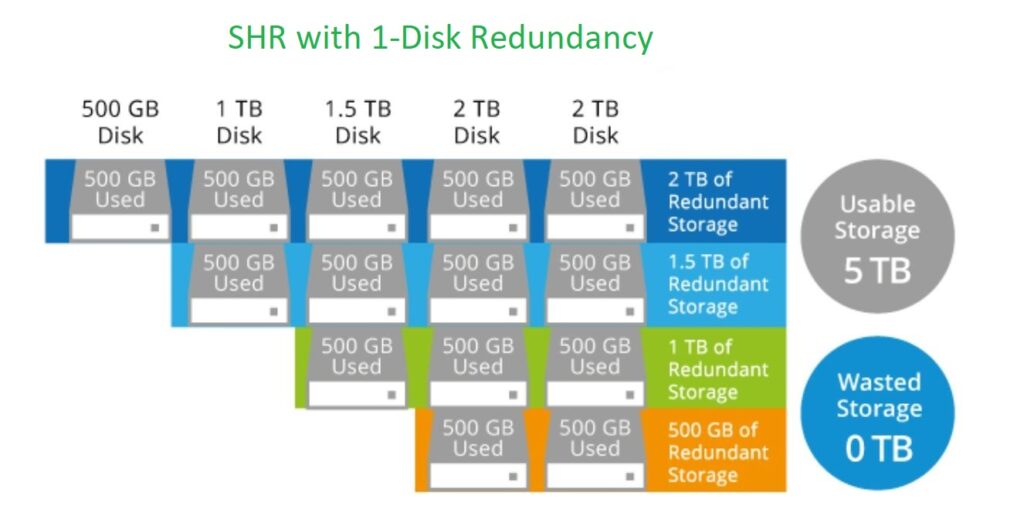
By default, SHR always uses one drive for redundancy. Nonetheless, if you have 4 drives or more than, you can choose to use SHR-2, which reserves two drives for redundancy, like to RAID half dozen.
By the way, you lot can offset with SHR and upgrade to SHR-2 later, only you lot tin can't do the opposite.
I've used SHR for years and dearest it. It delivers first-class performance. It's generally slower than equivalent standard RAIDs only past small-scale margins. The philharmonic of the resiliency in data prophylactic and the flexibility in mixed drive back up is more than than enough to make up for the slight loss in performance.
For case, SHR (not SHR-2) can survive when more than one drive fails simultaneously. That's nearly always the case if you haven't filled the RAID with more data than the surviving disc(s) can hold.
Nevertheless, by and large, SHR is just suitable for home or small business applications. If you go super-professional person, it might be a better thought to use a standard RAID.
Why Synology is the all-time NAS choice?
SHR alone makes Synology servers superior to those from other vendors. But this flexible RAID setup is just i of many things that make Synology NAS cracking.
Sure, Synology is not the only NAS vendor on the market place, in the past two decades, and I've had the opportunity to work with servers from virtually all other vendors.
For basic network storage needs, most, if not all, NAS servers will evangelize. Some are also easier to use, and most are certainly more than affordable than those from Synology.
I don't desire to sound similar Synology has paid me to write this — it didn't and I didn't ask — but if you want to get the well-nigh out of network storage, definitely pick a Synology. Synology is so far ahead that since 2020, I have decided to no longer actively seek to exam any other NAS brands — that'd not exist a good use of my time.
And that's truthful for both home and business organisation users. Let's beginning with the naming of its servers.
Synology's NAS naming convention
Synology NAS servers come in different tiers and models.
Dependent on the number of drives they can house, their hardware specs, and release year, you lot'll see names like DS1621+, RS1619xs, FS1018, then on. It'southward a good idea to know what those names mean.

There are three parts in the names, the leading letters, the numbers, and the ending letter(s)/characters. Here's the breakdown of how to translate them for home and business models:
The leading messages in a Synology NAS server'due south name
This part has 2 or three messages that show the types of the server:
- DS stands for DiskStation: A desktop design with drives installed vertically. This type is a popular design for general consumers.
- DX (DiskStation Expansion): This name is for expansion units that extend the capacities of supported DS server blazon higher up.
- RS (RackStation): A rackmount design server with drives placed horizontally.
- RX (RackStation Expansion): This one is some other expansion unit, but for an RS server.
- FS (FlashStation): A desktop operation-oriented pattern built especially for 2.five-inch solid-state drives.
- NVR (Network Video Recorder): A server designed more often than not to piece of work as a video recorder.
- VS (Visual Station): This server is 1 dedicated to the Synology Surveillance Station.
- SA: This series is for scalable enterprise storage solutions and mostly not applicable to home and SMB users.
The number role in a Synology NAS server's name
This office includes iii or four digits to indicate:
- The last 2 numbers point the release year. For example, xviii means the server is the 2018 model year. (Sometimes, a server is available one year earlier than its intended model yr. The DS620slim, for instance, came out in 2019.)
- The digit (southward) preceding the model year prove the max number of internal drives the server tin firm, including when used with expansion unit of measurement (s).
The ending letters/characters in a Synology NAS server'due south name
This part shows the tier a server:
- XS: A top-tier, expensive server that's the all-time of the all-time. This server is designed to deliver maximum performance and includes the most extended warranty with the best support. It's suitable generally for businesses that require high availability and uncompromising performance.
- Plus (+): A high-stop server that can do everything a standard server can and much more. (Note that not all plus servers can do 4K transcoding, which depends on the processor.)
- (Nothing): This is a standard server. If a server'due south proper name doesn't end with a letter or charactor, it's a server that's better than J but lower than Plus. It might or might not have 4K transcoding adequacy. There are two addtional season of standard server:
- Play: A standard server with accent on home entertainment. Its hardware prioritizes photos, movies, and music over other functions. A Play server is always capable of 4K transcoding.
- Slim: A standard compact desktop server that uses ii.5-inch drives.
- J: This is a lower-tier than a standard server with decent hardware. It'due south generally weak in operation and features.
- SE: An entry-level server with the lowest hardware specs. It'due south affordable but suitable only for basic needs. Information technology's designed to handle a single task at a time.
With that, here's an example of how to interpret a server's name: the DS1621+ is a 2021 desktop server that can house up to 16 drives and belongs to the Plus series. The server itself houses only six drives, but it can host ii 5-bay expansion units.
Synology servers and storage limits
You might have heard that Synology servers support a limited storage size. Well, that's true for all servers.
In the case of Synology, it'due south pretty simple. There are three volume size limits, 16TB, 108TB, and 200TB.
Specifically, a server running a 32-bit CPU, including most standard and low-tier servers, has a volume limit of 16TB.
Servers with a 64-chip CPU — that's most Plus (+) servers and those released in the past five years — tin can handle 108TB per volume, and nigh XS and higher-finish servers can command 200TB per book.
Some servers tin practise larger than 200TB volume size. Almost are enterprise-class machines with at least 64GB of RAM and run DSM 7.0.1 or later on.
Information technology's important to note that a server can have multiple volumes, then you can always use two or more to double or triple their storage space. Using multiple volumes is not a bad thought since it'd give y'all more options in fill-in and replication — y'all only have to put data in different shared folders.
If you lot want to know which sever tin can handle which volume size, click the button below to find their model numbers.
Actress: Synology servers and their book size limits
The list below is based on the information from Synology.
Last updated: Early 2022.
- 16TB volume limit:
- 19-series: DS419slim
- 18-series: DS218j, NVR1218
- 17-series: RS217
- 16-serial: RS816, DS416, DS416slim, DS416j, DS216, DS216play, DS216j, DS216se, DS116, NVR216
- 15-series: RS815, DS415play, DS215+, DS215j, DS115, DS115j
- 14-series: RS814, RS214, DS414, DS414slim, DS414j, DS214+, DS214, DS214play, DS214se, DS114
- 13-serial: DS413, DS413j, DS213+, DS213, DS213j, DS213air
- 12-series: RS812, RS212, DS212+, DS212, DS212j, DS112+, DS112, DS112j
- eleven-series: RS411, DS411, DS411slim, DS411j, DS211+, DS211, DS211j, DS111
- 10-series: DS410, DS410j, DS210+, DS210j, DS110+, DS110j
- 108TB volume limit:
- 22-series: DS2422+
- 21-series: RS2821RP+, RS2421RP+, RS2421+, RS1221RP+, RS1221+, DS1821+, DS1621+, DVA3221
- xx-series: RS820RP+, RS820+, DS1520+, DS920+, DS720+, DS620slim, DS420+, DS420j, DS220+, DS220j, DS120j
- 19-serial: RS1219+, RS819, DS2419+Two, DS2419+, DS1819+, DS1019+, DS119j, DVA3219
- 18-serial: RS2818RP+, RS2418RP+, RS2418+, RS818RP+, RS818+, DS1618+, DS918+, DS718+, DS418, DS418play, DS418j, DS218+, DS218, DS218play, DS118
- 17-series: DS1817+, DS1817, DS1517+, DS1517
- xvi-series: RS2416RP+, RS2416+, DS916+, DS716+Ii, DS716+, DS416play, DS216+Ii, DS216+
- xv-series: RS815RP+, RS815+, DS2415+, DS2015xs, DS1815+, DS1515+, DS1515, DS715, DS415+
- 14-serial: RS2414RP+, RS2414+, RS814RP+, RS814+
- 13-series: DS2413+, DS1813+, DS1513+, DS713+
- 12-series: RS3412RPxs, RS3412xs, RS2212RP+, RS2212+, RS812RP+, RS812+, DS3612xs, DS1812+, DS1512+, DS712+, DS412+
- 11-series: RS3411RPxs, RS3411xs, RS2211RP+, RS2211+, DS3611xs, DS2411+, DS1511+, DS411+2, DS411+
- 10-serial: RS810RP+, RS810+, DS1010+, DS710+
- 200TB volume limit
- FS-serial: FS6400, FS3600, FS3400, FS3017, FS2500, FS2017, FS1018
- SA-series: SA3600, SA3400, SA3200D
- 22-serial: DS3622xs+
- 21-serial: RS4021xs+, RS3621xs+, RS3621RPxs, DS1621xs+
- nineteen-series: RS1619xs+
- 18-series: RS3618xs, DS3018xs
- 17-serial: RS18017xs+, RS4017xs+, RS3617RPxs, RS3617xs+, RS3617xs, DS3617xsII, DS3617xs
- 16-series: RS18016xs+
- 15-series: RC18015xs+, DS3615xs
- 14-serial: RS3614RPxs, RS3614xs+, RS3614xs
- thirteen-serial: RS10613xs+, RS3413xs+
- Over 200TB volume limit (Servers must support Btrfs Peta Volume with a minimum of 64GB of RAM, and run DSM 7.0.i)
- FS-series: FS6400, FS3600, FS3400, FS2017
- SA-series: SA3600, SA3400
- 21-series: RS4021xs+, RS3621xs+, RS3621RPxs
- 19-serial: RS1619xs+
- eighteen-serial: RS3618xs
- 17-series: RS18017xs+, RS4017xs+, RS3617xs+, RS3617RPxs
Synology NAS server: State-of-the-art operating arrangement
All Synology NAS servers run a Linux-based operating arrangement, called DiskStation Manager (DSM), of which the latest 7th revision came out in July 2021.

For this reason, no matter which model y'all get, you lot'll take the same core experience. DSM is where the power of Synology NAS servers lies. It's by far the virtually advanced and robust NAS Bone.
You access this OS via its web interface — the way you do a router –, but DSM behaves like whatever other desktop Bone within the web page.
Information technology has a showtime button, a desktop, a taskbar, and a control panel. When working with it, you tin open and rearrange multiple windows, log in, log out every bit different users, etc., all with transitional furnishings.
In all, working with a Synology NAS server is similar to with a real Windows or Mac calculator. DSM is robust and has excellent context-based help and clarification. If you're tech-savvy, you can figure things out quite chop-chop.
About importantly, DSM is consequent throughout the entire Synology ecosystem. As a result, when you know 1 Synology server, for the virtually part, you know them all. Once again, information technology's just similar any Windows or Mac OS.
Synology DSM's useful core settings and features
Similar all OSes, DSM has essential functions, such as user management, network settings, security, shared folders, Time Machine backup back up, and many others.
Information technology besides has the following, which makes Synology servers so powerful right out of the box:
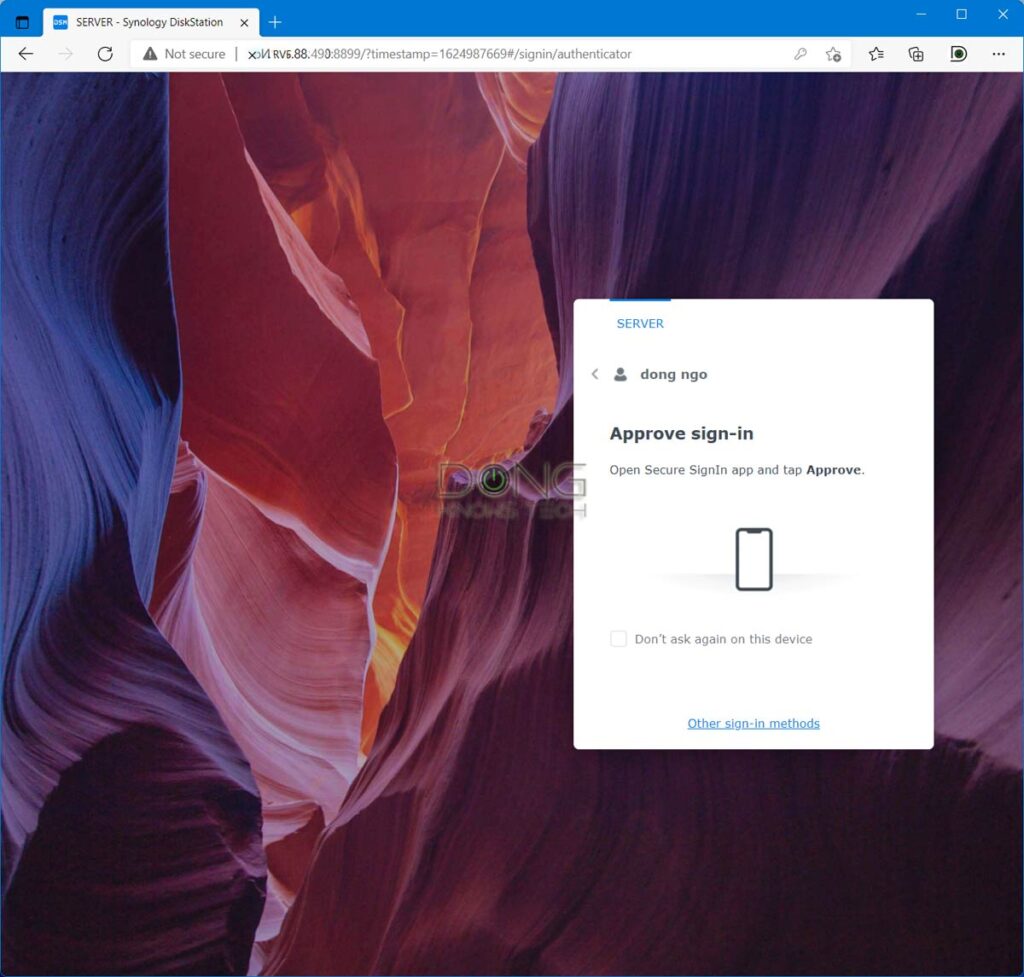
Advanced storage and user management, with 2-Factor Authentication login
Supporting all standard RAID and SHR, a Synology server delivers all the storage setup you'd desire, from the most basic to the nigh avant-garde levels.
Y'all tin can also prepare storage quotas for each shared folder and conveniently manage permission down to an individual sub-folder.
Starting with DSM 7, all Synology NAS server comes with the option of ii-Cistron Hallmark login, which you tin enforce on private accounts or a user group.
Once turned on, users can employ the phone or an app as a verification key for added security. They can also trust specific devices, making subsequent logins less of a hassle.
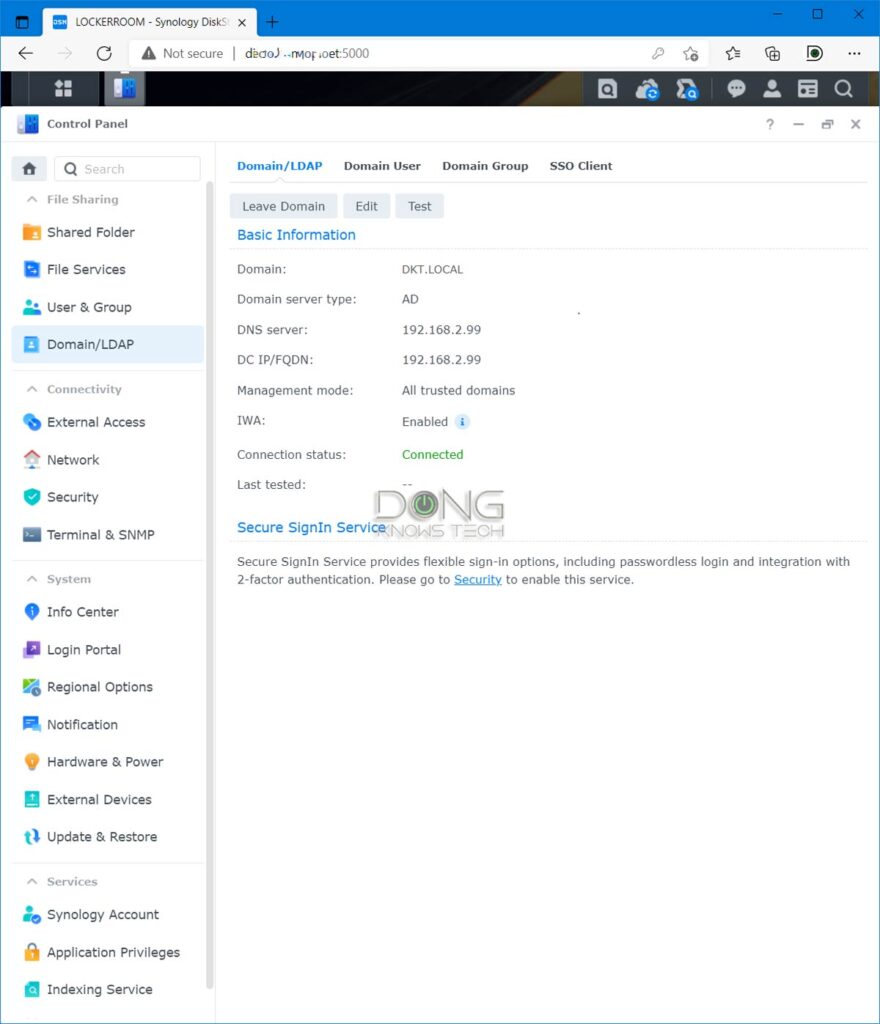
Active Directory integration
This powerful business feature allows the NAS server to exist office of a network with a Windows Server. One time integrated, you can manage NAS's resources based on the settings of the domain server.
QuickConnect, VPN, DHCP, Dynamic DNS, DNS and so on
QuickConnect is an easy and quick way to utilize your server remotely.
All y'all need to practice is annals a unique name. Afterwards that, you lot can admission your NAS from anywhere, using quickconnect.to/UniqueName equally the address.
Starting with DSM 7, these features include a gratuitous SSL certificate, making remote management a much improve experience.
If you lot don't want to have an account with Synology, you can skip QuickConnect and use Dynamic DNS. You tin can too set up upwards the NAS every bit a VPN, DNS, and DHCP server.
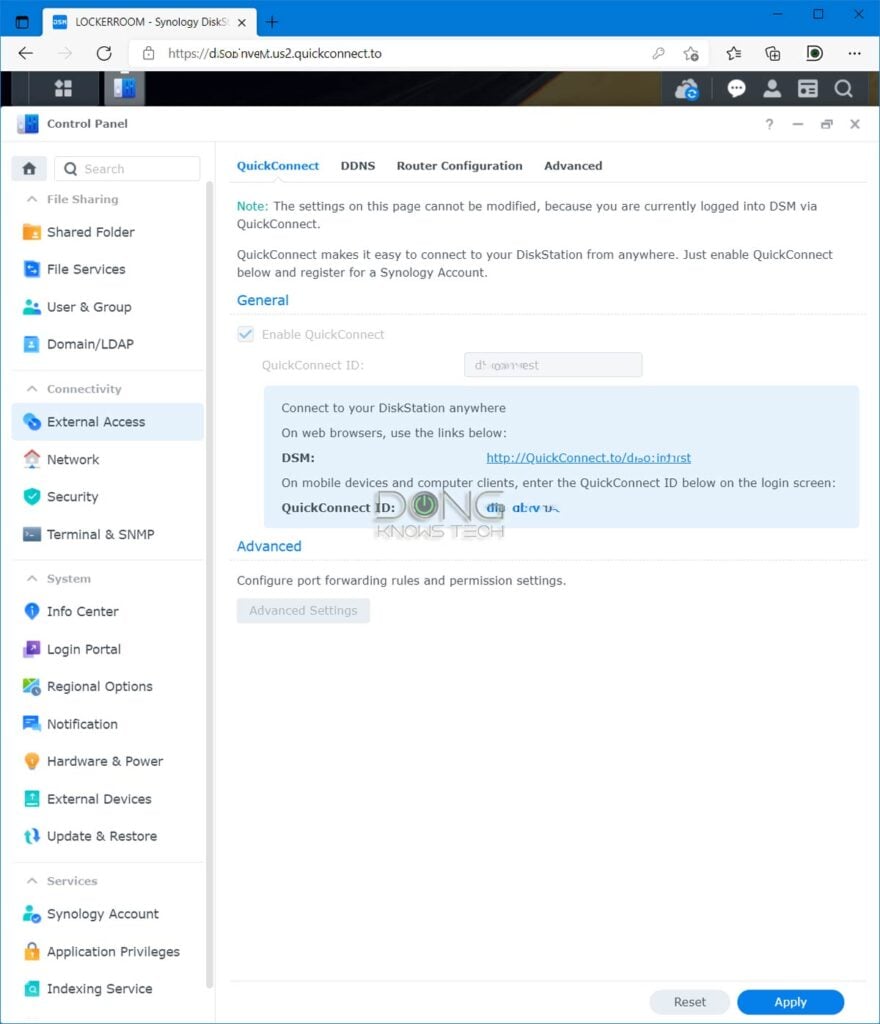
Mobile apps
Many Synology NAS applications have their own mobile versions.
That, plus the QuickConnect characteristic, means you lot can use your smartphone or tablet to access your server from anywhere.
Examples are content streamings, surveillance apps, photos sharing, download, etc. By itself, y'all tin can utilise DS File mobile app to admission shared folders and motion data betwixt the server and the mobile device.
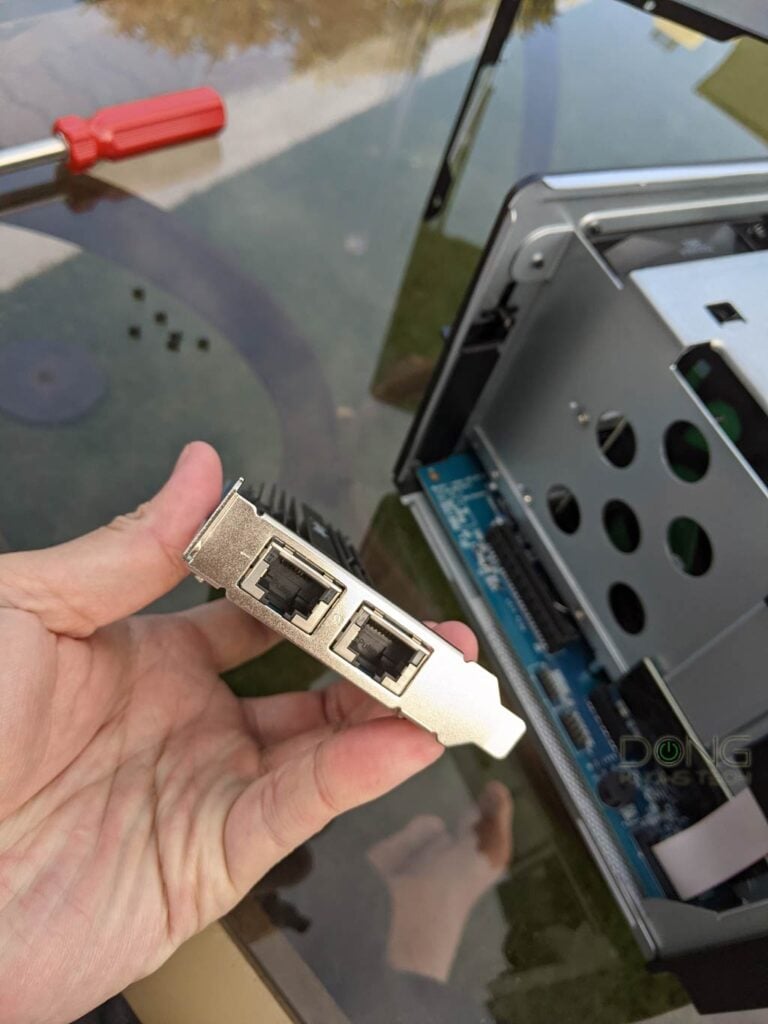
Sync shared folders in real-time with another Rsync-compatible server — all Synology servers support this — to accept another live copy of your data.
Shared Folder Sync works locally and over the Internet via VPN or QuickConnect.
Link Assemblage, PCIe addition options
For servers that have two or more network ports, you lot can combine two ports into a single 2Gbps connectedness to boost the server's throughput speed.
Specific servers also accept a PCIe add-on slot to host a 10Gbps network adapter or SSD cache.
Parcel center
That's an app store where you can install more applications that add features and functionalities to the server.
Synology offers some 100 and counting gratuitous, high-quality apps, and you can too manually install apps from third-party developers.
The Package Center is the most powerful feature of a Synology server. It opens up the hardware to endless possibilities.

Synology NAS server: Well-thought-out, useful applications
My servers play such an essential function in my daily life because of their apps.
As mentioned above, in that location are more than than 100 official apps. I haven't had the demand (or time) to try them all, but those I've used are incredibly useful.
The following are a handful of popular apps, any one of which lone is plenty to justify the cost of a server. Again, you can run most, if non all, of these apps and more than, at the same fourth dimension.
Synology Drive
Including a server bundle and customer apps, Synology Drive turns the NAS into a personal deject server, like Dropbox, just much better.
To utilise it, you need to install and install the server app from the Package Center. After that, download and install the Synology Drive Customer desktop app on your computer. There'due south besides the DS cloud mobile app for your phone/tablet.
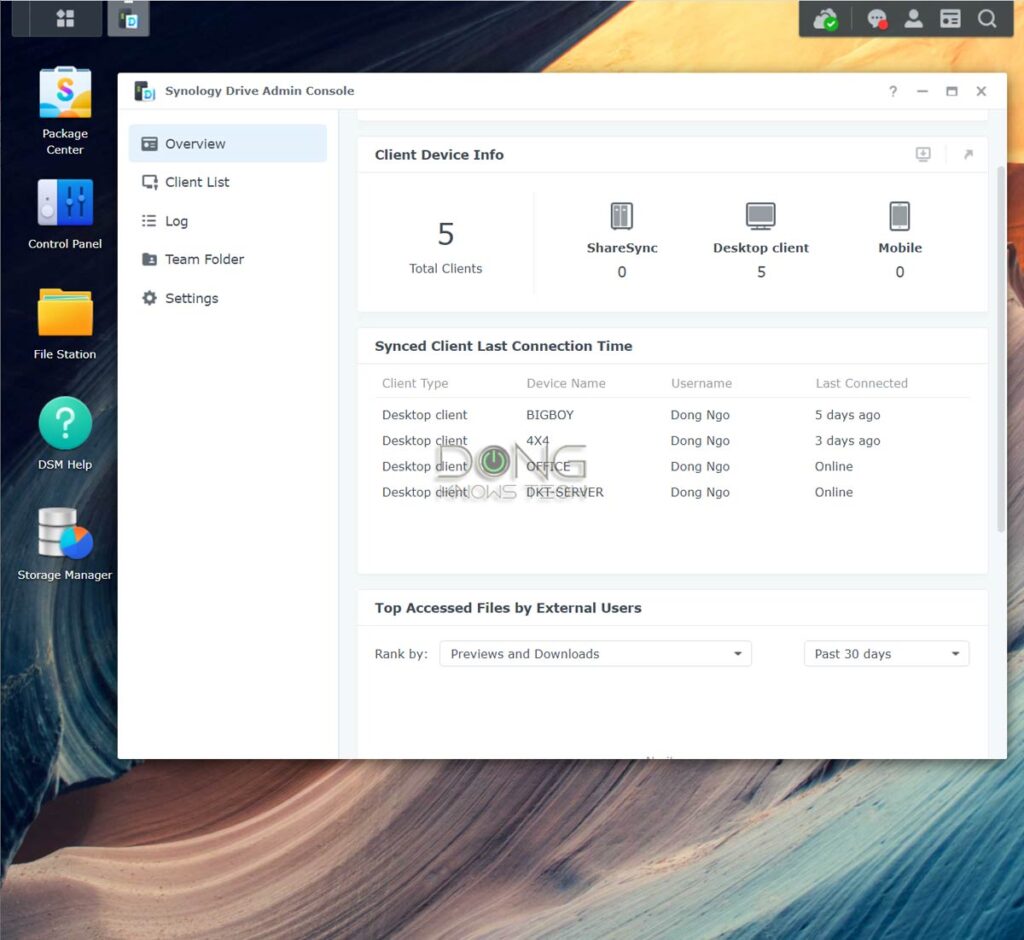
With that, you lot can sync or backup information across multiple (hundreds of) devices in real-fourth dimension. The way it works, the NAS server will retail a copy of the data and sync that with the clients. You tin even choose to utilize "On-demand Sync" on a client to salve its storage space.
This function works within the local network or over the Internet (via QuickConnect mentioned above or a Dynamic DNS connectedness). There'south no storage limit other than that of the server itself.
Y'all tin turn on this characteristic for all the user accounts on the server, and each account will take its ain private sync/backup space. It's simply like having multiple unlimited Dropbox accounts for free.
Imagine always having your data backed upwards and synced in real-time, no matter where you lot are, without y'all having to do anything (other than the initial setup). Once yous've had that, it's hard to turn dorsum.
Surveillance Station
You lot tin can plough your Synology server into a powerful surveillance organization via the Surveillance Station app past adding supported IP cameras.
This app works with a big number of IP cams on the marketplace. Fifty-fifty if a camera is not on the listing, as long equally information technology supports ONVIF, you can configure it to work with the Surveillance Station.
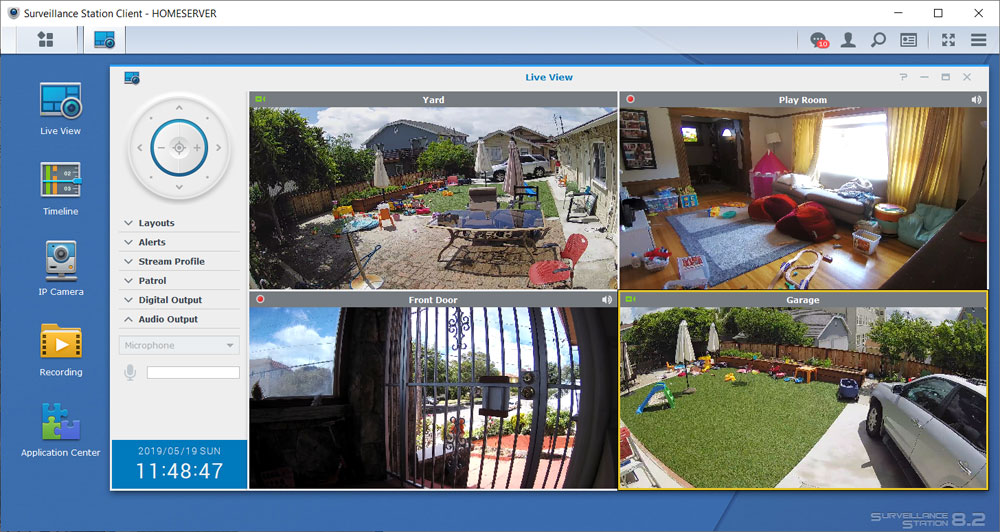
Once prepare up, yous can use a browser to keep tabs on your dwelling house in real-time or view recorded video based on motion detection. You tin can also exercise that via the DS Cam mobile app. For more, bank check out my full review of the Surveillance Station.
Video Station
This app is one of the many streaming features of a Synology NAS. It automatically organizes movies and TV shows and casts them to the DS Video app, which is available on many platforms, including iOS, Android, Roku, Xbox, Fire Stick, etc.
Again, you tin can stream content when you're in the local network or out and about using QuickConnect. Alternatively, Synology NAS also supports Plex and other streaming platforms.
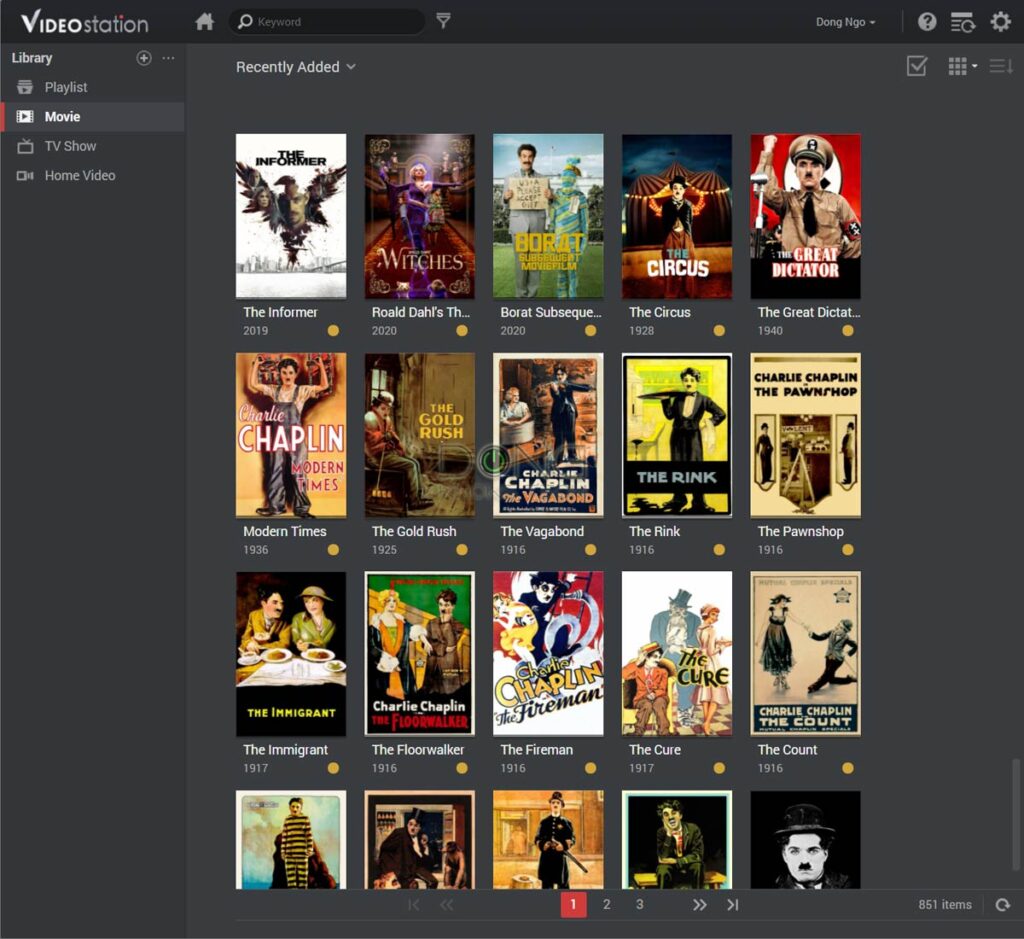
Keep in mind that, by default, Video Station doesn't support DTS sound, merely you tin can quickly fix that with a 3rd-party app on the front cease, such every bit VLC.
Download Station
Download Station is the best way to download anything from any source. Download Station will come up in very handy if y'all need to go a large file that takes a long time to download, such as an ISO file of a Linux distro.
Yous can run many downloads simultaneously and queue an unlimited amount of downloads. And you tin also set the max download speed to ensure the server doesn't sus scrofa all the Internet bandwidth and many other settings options.
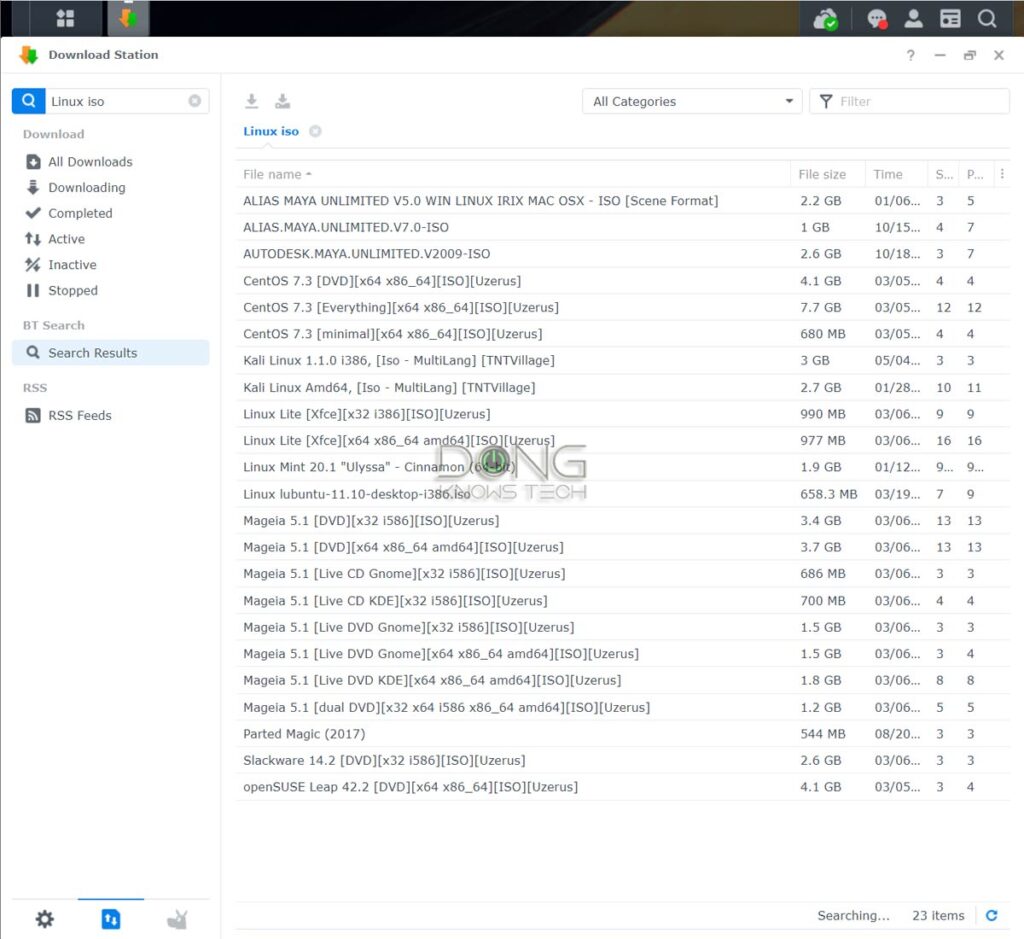
In that location'due south as well a search function that will expect amid BitTorrent sources for what you want. Double-click on it when you detect something, and the download volition showtime.
What'due south cool is that yous tin can manage your download remotely via the DS Get mobile app.
Virtual Machine Management
Synology'due south VMM is one of the about powerful NAS add-on features.
Available in many servers released in the by ten years, information technology allows the NAS server to house multiple virtual machines on the within.
In other words, yous can run inside the NAS server multiple virtual "computers," including Windows, Linux, and Virtual DSM, allowing yous to operate a whole organization in a sandbox for all kinds of advanced applications.

This characteristic likewise means you can have an advanced network setup without getting boosted hardware. In fact, with the Active Directory integration mentioned above, you can take a Windows Server-based accelerate network without a split up server.
Snapshot and Replication: The ultimate ransomware protection
Available in all server that supports the new Btrfs file system — most Synology server released in the past decade practice — the Snapshot Replication is an first-class addition security feature.

The Replication portion works somewhat similar the folder sync mentioned to a higher place and requires boosted volume (or storage devices.) It can be a flake redundant.
On the other hand, the Snapshot portion is a must-use. Information technology's essentially a shadow copy feature that automatically saves a version of the server's information, by shared folder, on a schedule.
In the case of unwanted data altercation, such equally afterwards a ransomware attack, you can restore the data to the previous version, either the entire shared binder or past selecting private files.
In all, the combo of the ii-step verification for login and Snapshot ways yous can rely on your Synology server to proceed your data safe against malicious changes.
Synology NAS server: Easy hardware setup
All Synology servers released in the past few years share a similar design. Most of them are tool-free, while others only require a standard screwdriver. They come up with front-facing drive trophy, and you lot can easily supercede/install drives.
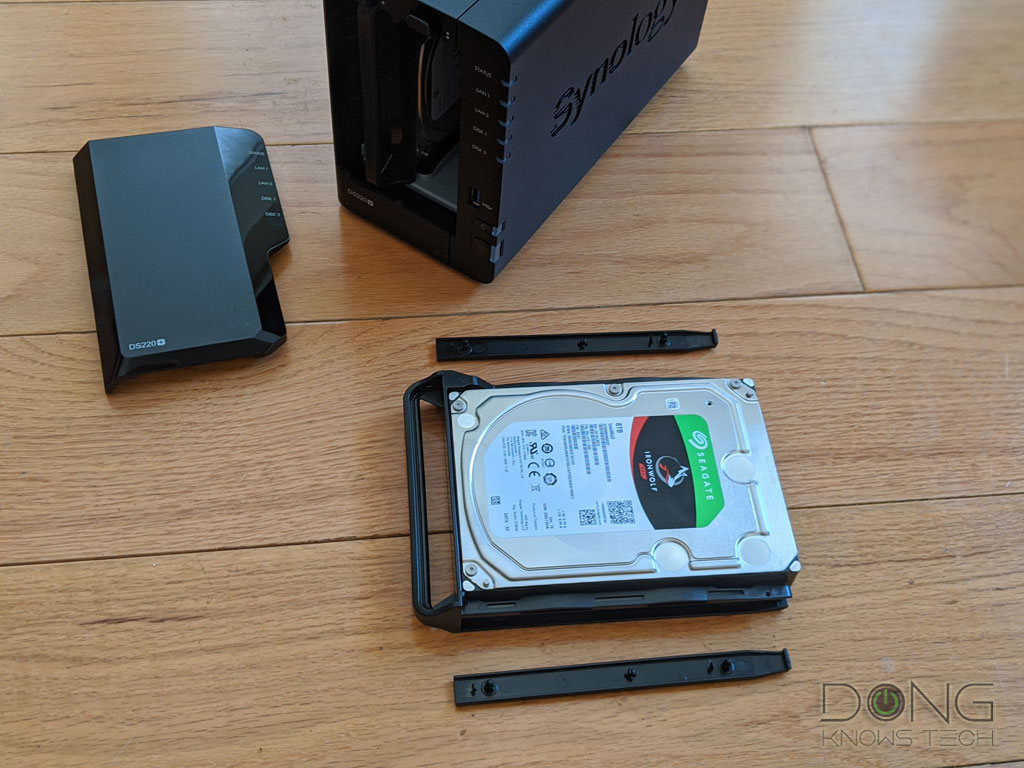
Equally for software, NAS servers are generally not for novice users who desire something plug-n-play. That's also the example with a Synology. That said, if you're a tech enthusiast, though, you'll take no trouble figuring one out.
Steps to set up any Synology server
It's straightforward to prepare upwardly whatsoever Synology NAS box. Here are the common detailed steps.
- Mount the internal drives on to the drives trays and insert them into the server. By and large, each tray can house either a 3.5-inch (desktop) or a 2.5-inch (laptop) drive. Former won't require an adapter, not even screws in newer servers. Synology servers work with all standard SATA drives on the market, including the Seagate IronWolf 110 SSD, or the WD RED SA500. However, it's a good thought that you apply NAS-specific drives.
- Connect the server to your router or switch using a network cable and turn it on. By the way, make certain you use one of the its built-in LAN port for this part. An add together-on 10Gbps carte du jour — as mentioned above — only works after a server has been prepare.
- On a connected computer, download, install, and run the Synology Assistant software. The application will detect the server from your network.
- Double click on the detected server and follow the wizard to install the DiskStation Managing director (DSM) operating system directly from Synology's website and stop with the initial setup process.
- Log in to the web user interface and customize your server the way you want.
Another cool thing almost using Synology NAS servers is that yous tin chop-chop migrate from one server to another without losing data or system settings. That comes in handy when you demand to replace your server due to hardware issues or upgrade to a newer one.
And this procedure works as a downgrade, as well. The simply requirement is that the destination server has the same or more than drive bays than your existing unit of measurement.
And here'due south how to exercise it: physically remove the internal drives from the onetime server and install them into the new server, preferably in the same club. That'southward it!
After that, the offset time you plough the new server on, you'll exist prompted to upgrade the Bone, like in footstep #iv above, to the latest version of DSM congenital for the model. Subsequently, all data and most settings of the old server will exist present in the new one.
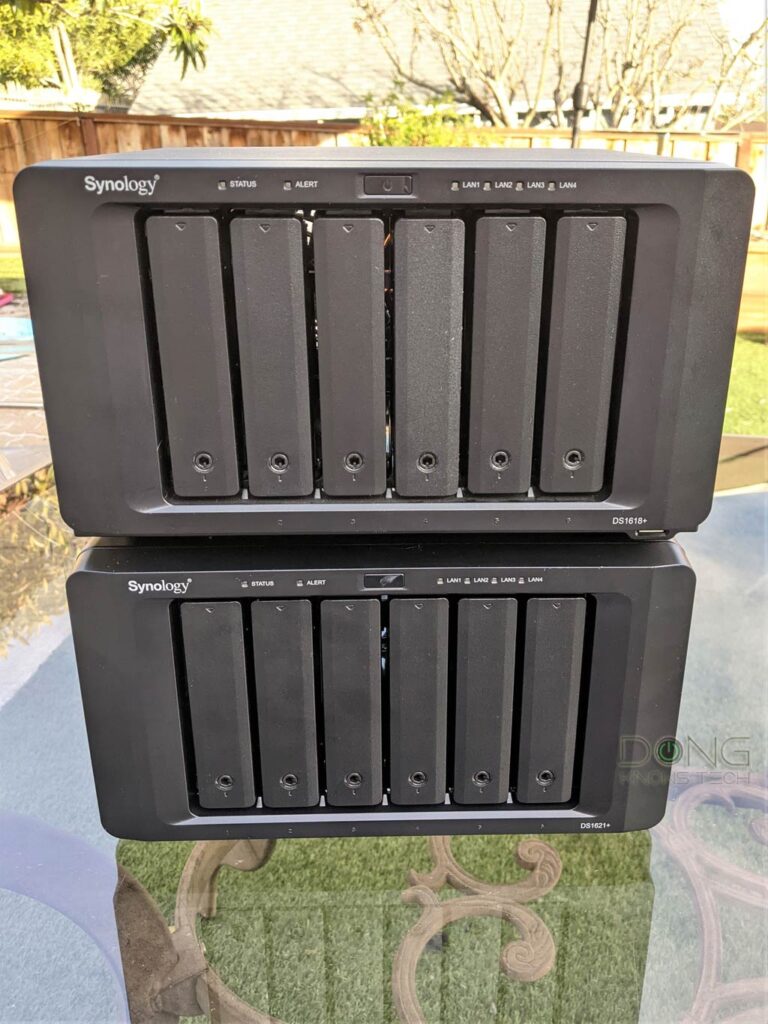
***
There y'all take it! Now you know why my Synology NAS has been essential for my daily life and why I wouldn't go with any other brand.
And so, no issues? Really?
I can't find anything purely negative virtually Synology NAS. In fact, of all servers I've used over the years, I had issues with just one, the DS1515+, which died afterward nigh four years of not-finish functioning.
However, that turned out to be the fault of Intel'south chip and not Synology. Past the way, Synology promptly replaced mine for free, even though information technology had already been out of warranty.
Only just like everything else, these servers are not perfect. Here are a couple of things you should continue in mind before getting a Synology.
- The cost: Synology servers tend to exist more expensive than counterparts if you lot compare the hardware specs. The TerraMaster F2 210, for example, has about the same hardware specs as the DS218+ but costs less than half.
- Expensive RAM upgrade: Synology servers require Synology-approved RAM, which is expensive, costing many times more than RAM other vendors. Some models, such as the DS419slim, come up with little RAM and have no option for upgrades.
- Merely two IP cameras allowed out of the box: The Surveillance Station is ane of my favorite apps, merely each home/SMB Synology server can host just two cameras out of the box. If y'all desire to utilise more than cameras, you'll have to buy additional licenses at some $60 a popular.
- Express support for USB addition devices: Starting with DSM vii, Synology servers sheds a vast collection of USB dongles. More often than not you can just use a server's USB ports for storage-related purposes.
And so, in the end, the most annoying affair about Synology NAS is the cost. But in this example, yous pay for what yous get.
Which NAS model should I get?
I've worked on nigh Synology home and SMB servers, starting with the kickoff servers released more than a decade ago. Since and so, I've owned more than a dozen, the latest being the DS1621+.
My very first personal server, the DS410, released in 2010, every bit the name suggests, nevertheless works, by the way.
But no matter what Synology NAS you get, you'll experience nearly, if not all, of what I previewed in a higher place. And residuum assured that your server will final. Here's proof: Synology's latest NAS OS, the DSM 7.0, supports servers equally old as the 2013 model twelvemonth.
That said, if y'all desire something uncomplicated, get a dual-bay server similar the DS220+. If you want more than storage infinite, get a five-bay DS1019+ or even the six-bay DS1621+ server. And if you need something compact, the DS620slim is worth considering.
But nearly importantly, trust me on the significance of a NAS server. Get one from any vendor that fits your upkeep. At the very least, y'all'll accept a proper backup solution. And if the server allows for remote access, information technology's always better to ain your cloud than employ one from a 3rd political party.
Source: https://dongknows.com/why-you-would-want-a-synology-nas-server/
Posted by: baileypludenis.blogspot.com

0 Response to "Can You Change To Shr-2 From Shr Later?"
Post a Comment